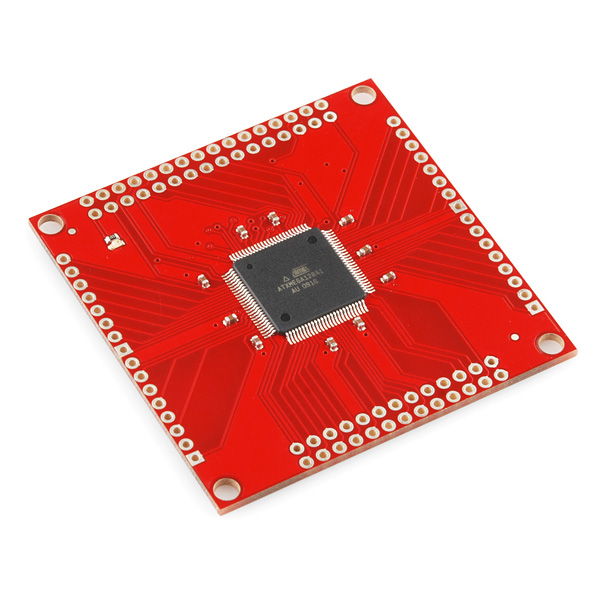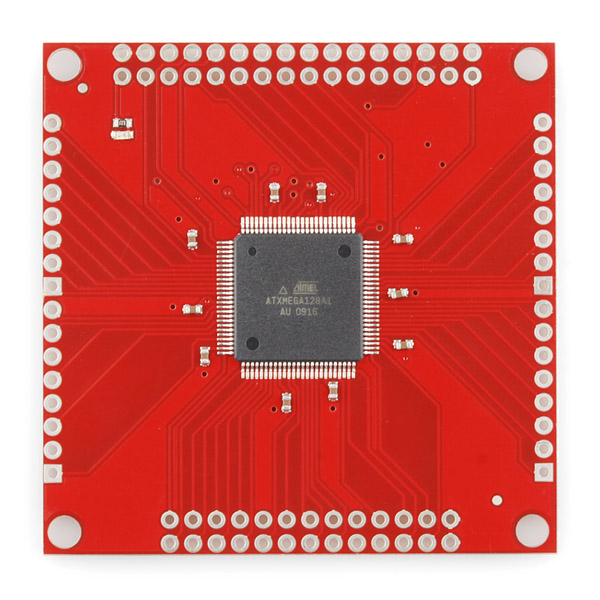XMega100 Breakout - Reverse Silkscreen
**Replacement: **BOB-09546. These were a limited run of misprinted boards but you can still get the board with the correct silkscreen. This page is for reference only.
This is a breakout board for the 100-pin TQFP package of Atmel's ATxmega128A1. The ATxmega128A1 is a low power, high performance and peripheral rich CMOS 8/16-bit microcontroller based on the AVR enhanced RISC architecture.
Among the chip's many features are 128kB of flash memory, 8 kB SRAM, 78 I/O pins, eight 16-bit timers, sixteen 12-bit ADCs, four 12-bit DACs, eight USART, four SPI and four TWI interfaces. This powerful chip can process up to 32 MIPS when running at its maximum clock speed of 32MHz. The operating voltage of the xmega is 1.6 to 3.6VDC.
All VCC pins of the ATxmega128A1 are connected together and brought out to a single header pin, same goes for the GND and AVCC pins of the chip. We've also included decoupling capacitors, and a red power indicator LED; but beyond those we've tried to keep the board as simple and straightforward as possible. If you want to start developing with this chip, but don't want to deal with soldering it, this is the board for you!
**Note: **The 6 pins labeled ICSP are used to program the board through the PDI interface using the common 6 pin ICSP cable found on most AVR programmers. Also, this board ships with the example code shown below and the JTAGEN bit set to 1 (JTAG disabled, PDI enabled).
- All pins of the ATxmega128A1 broken out to 0.1" spaced pins
- 0.1uF decoupling capacitors placed near VCC inputs of the chip
- 2x3 AVR ICSP connector broken out
- Red power indicator LED
- ATxmega128A1 Features:
- High-performance, low-power 8/16-bit microcontroller
- 1.6 - 3.6 VDC operating voltage
- 128 KBytes Flash
- 8 KBytes boot code
- 2 KBytes EEPROM
- 8 KBytes SRAM
- 4 DMA channels
- 32 MHz maximum clock frequency
- 78 programmable I/O pins
- Eight 16-bit timers
- Eight USARTs, four SPI, and four TWI interfaces
- Two Eight-channel (16), 12-bit, 2 Msps Analog to Digital Converters
- Two Two-channel (8), 12-bit, 1 Msps Digital to Analog Converters* 2.20 x 2.20" (55.88 x 55.88mm)
Comments
Looking for answers to technical questions?
We welcome your comments and suggestions below. However, if you are looking for solutions to technical questions please see our Technical Assistance page.
Customer Reviews
No reviews yet.





It would be nice to see a board like this for the MEGA 1280 and MEGA 2560 chips. I would rather have just the board because I am going to use this type of board in a project I am developing.
You shouldn't sell it as a failure, you should sell it as a puzzle. =)
I for one am excited for your new line of "nutkraps" devices
I submitted a board almost exactly like this through batch pcb not too long ago, for this exact chip. Funny how sparkfun carries a board for the same thing now, lol.
WHY did you disable the jtag fuse?
As it turns out the AVRdragon will NOT program or debug this part via PDI, but will via jtag. You don't put a jtag header on the board, but it's possible to just connect to the correct port pins if you want to use this part with jtag. The jtag can be disabled in software to make use of the I/O pins normally assigned to the jtag so there isn't a good reason to ship the part with this disabled. Atmel ships the chip with the jtag active.
Perhaps SparkFun bought them for a discounted price from a supplier that had a surplus of jtag disabled chips.
I agree - I don't know of anything affordable that can program this (with jtag disabled). There isn't a bootloader to use serial, and PDI isn't supported on the Dragon. You can see the comments in the original (nonmirrored) board.
avrisp mkii is fairly affordable and does pdi, programming only. Use it to enable jtag and then use the dragon.
Just call it the Arduino Da Vinci!